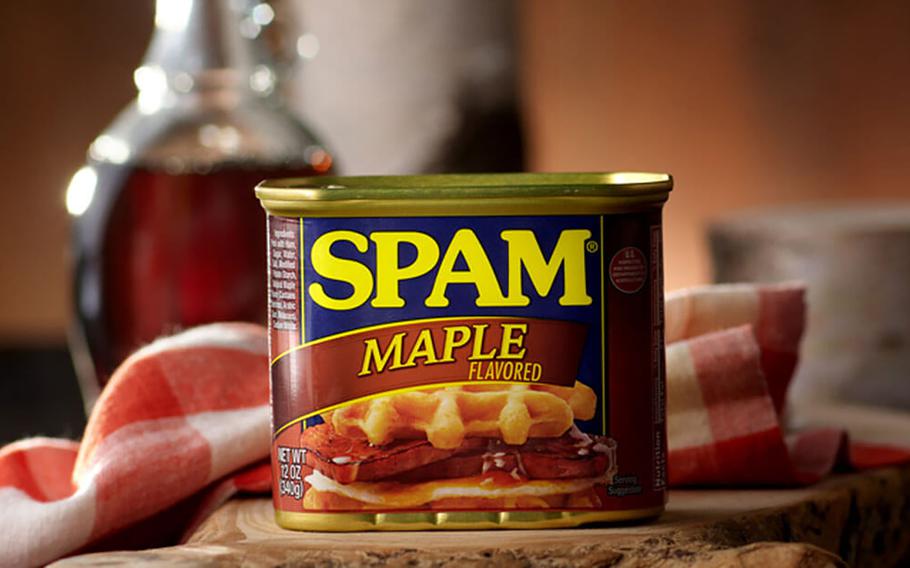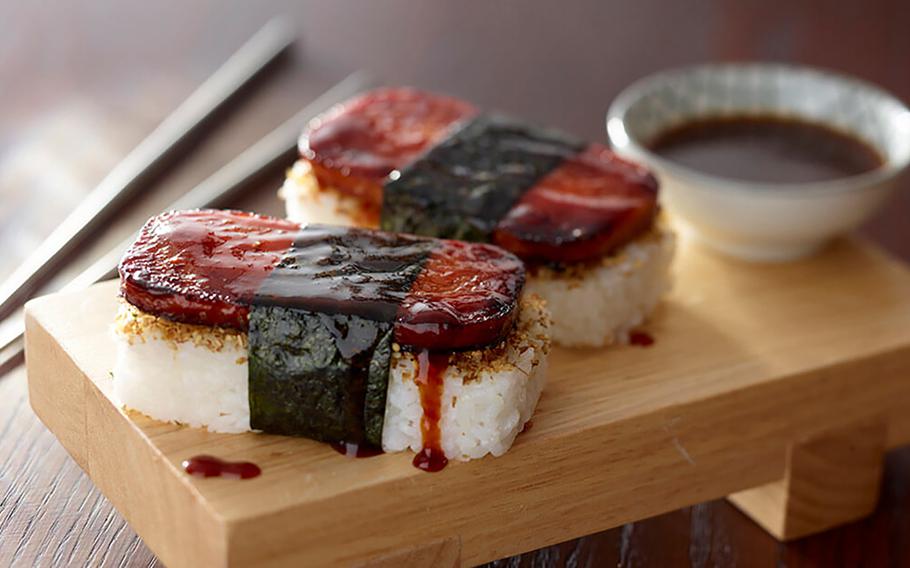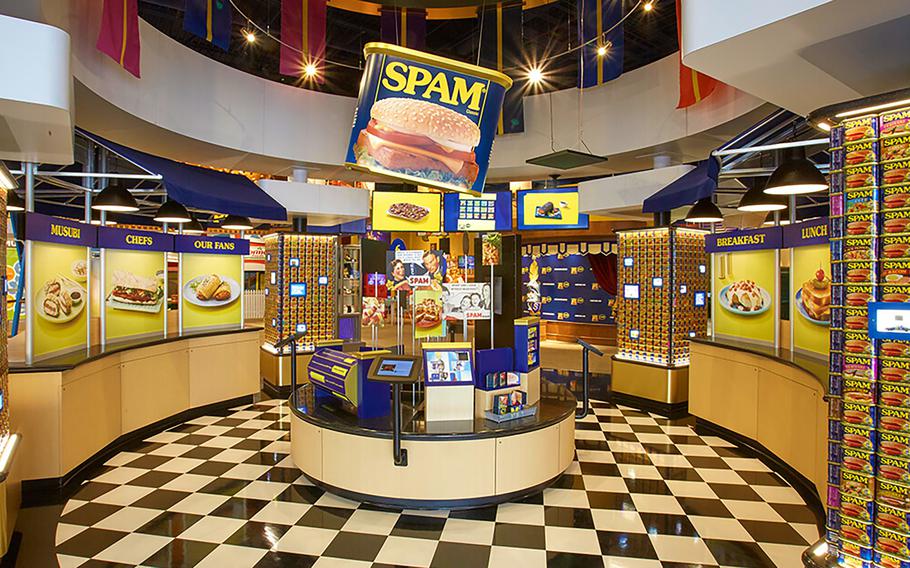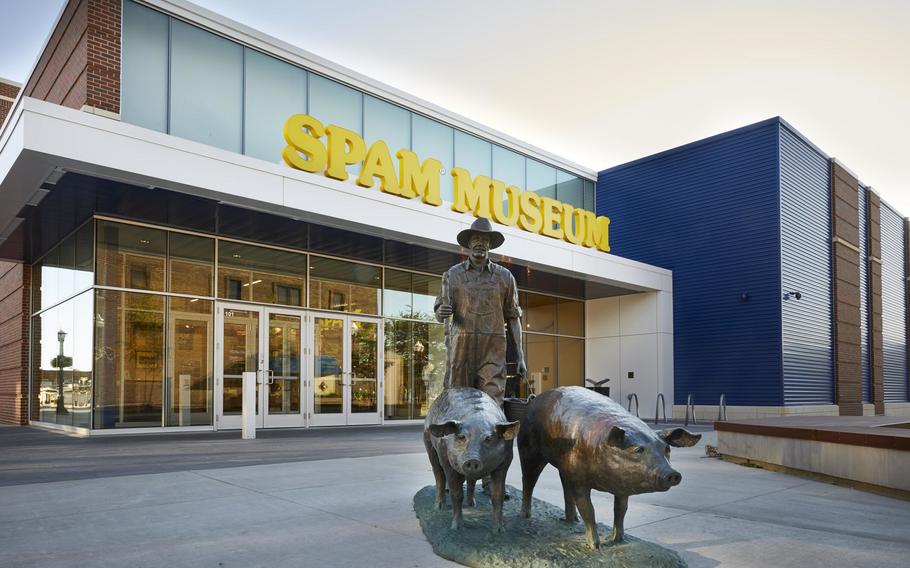
Sgt. Arnold Bourdreau eats canned corned beef in Italy in 1945. Spam fueled countless soldiers during World War II, inspired new international cuisine, spawned a museum and even led to the creation of a digital term people encounter on a daily basis. (National Archives)
AUSTIN, Minn. (Tribune News Service) — Spam is just canned meat with a catchy name. Yet its cultural legacy rivals any of Minnesota's other famous exports.
It fueled countless soldiers during World War II, inspired new international cuisine, spawned a museum and even led to the creation of a digital term people encounter on a daily basis. And nearly 90 years after it was introduced, Spam still commands a global army of fans.
"People always want to tell me their Spam stories," said Savile Lord, manager of the Spam Museum in Austin. "Nobody ever comes in and shares their tuna fish stories."
It's those Spam stories that keep the Minnesota-born luncheon meat in our cultural cupboards.
Spam is still a strong seller long after it was introduced in part because it's an affordable protein that works in a range of recipes. Its unique history as a ration staple during the second World War helped cultivate a nostalgic appeal for the canned meat in many corners of the globe.
How Spam was developed
The company known today as Hormel Foods was founded as a meatpacking operation in Austin in 1891 with a focus on processing hogs into bacon, ham and a variety of other pork products.
By the 1920s, Jay Hormel, son of company founder George A. Hormel, was on a quest to diversify the company's offerings beyond the often volatile world of commodity meat sales. He looked at the growing popularity of time-saving products — often canned, dried or preserved — that were sold in the center of grocery stores.
"To grow the business, being just a meatpacking company wouldn't be enough," Lord said. "They would have to continue to innovate, and center-of-the-store was the way to do that."
Hormel was first to develop a canned ham and later introduced a line of canned chicken. But competition, and soon the Great Depression, slowed sales.

Maple-flavored Spam is permanently joining the Hormel lineup. (Hormel/TNS)
Then came the first labor strike against Hormel in 1933. Worker demands for higher pay put pressure on the company to produce a reliable moneymaker.
"To keep every employee busy, to pay them and to turn a profit, Jay Hormel believed a stellar product was needed that would become a household word," according to a Hormel history book released in 1991 to commemorate the company's centennial.
Jay Hormel continued to look at canned meats for his breakthrough, and in 1936 the company debuted "Hormel spiced ham." It was innovative at the time for being cooked in its own can, and it helped the company find a use for otherwise unpopular pork shoulder. But again, competitors quickly flooded the market.
Hormel needed a catchier name to break through.
"Jay Hormel threw a New Year's Eve party in 1936 and offered $100 to whoever could come up with a name for this product," Lord said.
Kenneth Daigneau, brother of a Hormel vice president, proposed Spam, a portmanteau of spiced and ham.
"Names of that period were very punchy," Lord said, with brands like Ritz crackers, Skippy peanut butter and Kit-Kat bars premiering about the same time.
As Spam launched in 1937, national advertising campaigns were soon spinning Spam as "the meat of many uses."
"Cold or hot, Spam hits the spot," went the jingle featured in the popular "Burns and Allen" radio show, which also featured appearances by Spammy the Pig.
Packaging proved to be another signature element of the brand. Lord said the iconic Spam can — which hasn't changed since the early days — was fashioned after a canola oil can sliced in half.
World war brings Spam overseas
Hormel estimates that 70% of urban American households were eating Spam by 1940, thanks to successful advertising campaigns and a low price.
But its success soared during World War II, when the U.S. government put Spam on plates around the world.
Spam was famously supplied to American and Allied troops, who would jokingly call it "ham that didn't pass its physical," according to various media accounts. Hormel sent 15 million cans of Spam overseas every week.
"When you're fighting in a war, that's what you need — something quick, something easy," Lord said.
Spam also reached civilian dinner tables during the war thanks to the Lend-Lease Act of 1941, which delivered food rations to allies such as Great Britain and the Soviet Union.
"Though their tables will not be lavish, there will be Spam for everyone," famed war correspondent Edward R. Murrow reported from London during a Christmas broadcast.
Soviet Premier Nikita Khrushchev wrote in his autobiography that while "there were many jokes going around in the army, some of them off-color, about American Spam, it tasted good nonetheless."
"Without Spam, we wouldn't have been able to feed our army," he added.

Spam Musubi. (Hormel Foods/TNS)
Hawaii especially embraced the canned meat because of the large military presence there. Spam fried rice, Spam musubi and other recipes quickly became well-known Hawaiian staples. Today, Hawaiians consume more Spam per capita than residents of any other U.S. state.
The legacy of "Uncle Spam" lives on in South Korea as well. Budae jjigae (army base stew) includes Spam, hot dogs and cheese — things commonly found on American military bases on the peninsula following the war.
Lord said Spam gift sets are also popular in South Korea during the annual harvest festival.
"If you can afford to give this as a gift, it means you're doing really well," she said.
An enduring legacy
Former President Dwight D. Eisenhower paid his respects to Spam in a letter to Hormel in 1966.
"I ate my share of Spam along with millions of other soldiers. I'll even confess to a few unkind remarks about it — uttered during the strain of battle, you understand," he wrote. "But as former Commander-in-Chief, I believe I can still officially forgive you your only sin: sending us so much of it."
Spam has long been an easy target for jokes — which the brand has learned to embrace — but folks keep on eating the low-cost protein and shelling out for kitschy Spam merch.
Cans of limited-edition pumpkin spice Spam are selling for $85 and up on eBay.
"As a consumer behavior researcher, I believe Spam's widespread success can be attributed to two factors," Ayalla A. Ruvio wrote in the Smithsonian Magazine in 2017. "It addressed a real need, and also formed an emotional connection with its consumers, by tapping into American ideals like ingenuity and resourcefulness."
Hormel sold its billionth can of Spam in 1959 and has now sold more than 9 billion cans, according to the company. It is sold on every continent except Antarctica, the company says.
Spam fans around the world routinely trek to Austin, Minn., aka "Spamtown USA." Hormel opened a museum at its headquarters in 1991, and due to visitor demand the museum's focus quickly shifted to Spam. The current iteration of the Spam Museum in downtown Austin opened in 2016.

The Spam Museum in Austin, Minn. (Hormel Foods/TNS)
How 'spam' became email slang
Meanwhile, we have the Brits to thank for the brand's association with junk email.
The Monty Python sketch "Spam," which first aired in 1970, mocks the inescapable ubiquity of Spam at a diner and ends with a group of Vikings singing and chanting "Spam Spam Spam Spam Spam …"
That sketch is believed to have inspired the first use of "spam" to refer to unwanted or repetitive messages on an Internet forum in 1993, according to a spam history compiled by the Internet Society, a nonprofit organization. The lowercase word was added to the Oxford English Dictionary in 1998.
People across the English-speaking world now encounter the word "spam" on a daily basis in their email inbox — like in Gmail's spam folder.
Even though the Monty Python sketch plays at the Spam Museum, Spam maintains some distance from its lowercase offspring.
A few years ago at a conference, Hormel CEO Jim Snee was asked what he calls junk email. He answered quickly and definitively: "Junk email."
©2023 StarTribune.
Visit at startribune.com.
Distributed by Tribune Content Agency, LLC.

The Spam Museum averages more than 100,000 visitors annually, many from outside the United States. Last year, Spam fans from over 60 countries made the pilgrimage to Austin, Minn., to pay homage to the world-famous brand they love. (Hormel Foods/TNS)